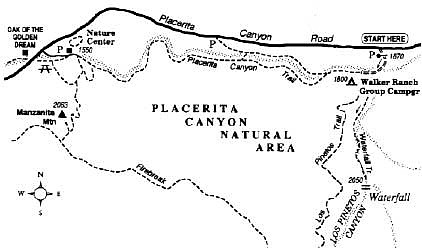 Facebook
Facebook
 X
X
 Instagram
Instagram
 TikTok
TikTok
 Youtube
Youtube
Barely ten minutes' drive from the northern San Fernando Valley and the sprawling suburb of Santa Clarita, Placerita Canyon Natural Area nestles comfortably at the foot of one of the more verdant slopes of the San Gabriel Mountains. Placerita Canyon's fascinating history is highlighted by the discovery of gold there in 1842. That event, which touched off California's first (and relatively trivial) gold rush, predated by six years John Marshall's more famous discovery of gold at Sutter's Mill in Northern California. The park's wild backcountry sector (as exemplified by the short hike described here) is complemented by a very civilized nature center -- the envy of many a national park -- housing exhibits on local history, pre-history, geology, plants, and wildlife.
Placerita Canyon is easy to locate. Take the Placerita Canyon exit from Antelope Valley Freeway (Highway 14) east of Interstate 5. Drive east 1.5 miles past the park's main gate and nature center entrance. Continue another 2 miles to a parking area at mile 5.4 according to the roadside mileposts.
On foot now, head south down to the Walker Ranch group campground. On the far side of the campground, turn south on the Waterfall Trail into Los Pinetos Canyon. Don't confuse this trail with the signed Los Pinetos Trail going up the slope west of the canyon bottom. The Waterfall Trail momentarily climbs the canyon's steep west wall, then drops onto the canyon's sunny flood plain. Presently you bear right into a narrow ravine (Los Pinetos Canyon), avoiding a wider tributary bending left (east).
Continue, now on an ill-defined path, past and sometimes over water-polished, metamorphic rock. Live oaks and bigcone Douglas firs cling to the slopes above, and a few bigleaf maples grace the canyon bottom. The bigcone Douglas fir (a.k.a. bigcone spruce), a Southern California variant of the Douglas fir of the Pacific Northwest, is abundant in the San Gabriel Mountains from elevations of about 2000 feet (as here) up to about 6000 feet. The bigleaf maple, also common in the Pacific Northwest, has gained a foothold in the San Gabriels as well, especially in moist canyons and ravines.
About 0.2 mile after the first fork in the canyon, there's a second fork. Go right and continue 50 yards to a sublime little grotto, cool and dark except when the sun passes almost straight overhead (it never does in winter), and a small waterfall. As you listen to water dashing or dribbling down the chute, enjoy the serenity of this private place and contemplate that it lies only three miles -- but a world away -- from the creeping boundary of the Los Angeles metropolis.


Barely ten minutes' drive from the northern San Fernando Valley and the sprawling suburb of Santa Clarita, Placerita Canyon Natural Area nestles comfortably at the foot of one of the more verdant slopes of the San Gabriel Mountains. Placerita Canyon's fascinating history is highlighted by the discovery of gold there in 1842. That event, which touched off California's first (and relatively trivial) gold rush, predated by six years John Marshall's more famous discovery of gold at Sutter's Mill in Northern California. The park's wild backcountry sector (as exemplified by the short hike described here) is complemented by a very civilized nature center -- the envy of many a national park -- housing exhibits on local history, pre-history, geology, plants, and wildlife.
Placerita Canyon is easy to locate. Take the Placerita Canyon exit from Antelope Valley Freeway (Highway 14) east of Interstate 5. Drive east 1.5 miles past the park's main gate and nature center entrance. Continue another 2 miles to a parking area at mile 5.4 according to the roadside mileposts.
On foot now, head south down to the Walker Ranch group campground. On the far side of the campground, turn south on the Waterfall Trail into Los Pinetos Canyon. Don't confuse this trail with the signed Los Pinetos Trail going up the slope west of the canyon bottom. The Waterfall Trail momentarily climbs the canyon's steep west wall, then drops onto the canyon's sunny flood plain. Presently you bear right into a narrow ravine (Los Pinetos Canyon), avoiding a wider tributary bending left (east).
Continue, now on an ill-defined path, past and sometimes over water-polished, metamorphic rock. Live oaks and bigcone Douglas firs cling to the slopes above, and a few bigleaf maples grace the canyon bottom. The bigcone Douglas fir (a.k.a. bigcone spruce), a Southern California variant of the Douglas fir of the Pacific Northwest, is abundant in the San Gabriel Mountains from elevations of about 2000 feet (as here) up to about 6000 feet. The bigleaf maple, also common in the Pacific Northwest, has gained a foothold in the San Gabriels as well, especially in moist canyons and ravines.
About 0.2 mile after the first fork in the canyon, there's a second fork. Go right and continue 50 yards to a sublime little grotto, cool and dark except when the sun passes almost straight overhead (it never does in winter), and a small waterfall. As you listen to water dashing or dribbling down the chute, enjoy the serenity of this private place and contemplate that it lies only three miles -- but a world away -- from the creeping boundary of the Los Angeles metropolis.
